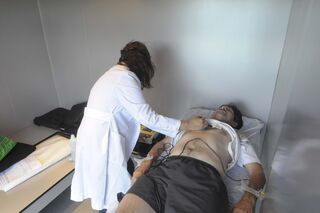Chronic Pain
Chronic Pain Is a Symptom
How would you make a diagnosis in chronic pain patients?
Posted May 23, 2021 Reviewed by Lybi Ma
Key points
- Current testing for diagnoses in chronic pain patients needs to be reduced.
- Diagnoses from psychiatry and medicine for unexplained chronic pain provide little help.
- Identifying interference with usual activities and life enjoyment can best guide treatment in chronic pain patients.
- Compromised life enjoyment and function in chronic pain predicts co-occurring depression, anxiety, and substance abuse that must be treated.
Trying to make a diagnosis in the patient with chronic pain confuses clinicians and interferes with care. In this post, I’ll review the diagnostic problem and suggest some ways around it.

In an earlier post, Chronic Pain Is Not A Disease, I indicated that chronic pain represents a symptom rather than a disease. Although some patients with chronic pain have an underlying disease causing the pain (such as sickle cell disease, cancer, diabetic neuropathy, or severe arthritis), most lack a disease diagnosis. We label such patients as having “medically unexplained symptoms.”1,2
So, clinicians have to resolve a dilemma—disease vs. unexplained pain. Most experts believe identifying (diagnosing) an underlying causative disease in patients with chronic pain should guide the initial encounter with a clinician. Why? Each disease has unique treatments we would not want to miss. The diagnostic effort should take little time: a careful history and physical examination and standard testing relevant to the patient’s pain can establish a diagnosis of disease or unexplained symptoms in short order so that treatment can begin for either condition.1

Not so fast. We’ll now consider the unfortunate but all-too-frequent situation where clinicians unearth no disease from this initial evaluation but do not proceed to treatment. Medicine’s disease-based system indoctrinates clinicians to believe that physical symptoms, such as pain, bespeak an underlying disease. This principle of “clinical-pathological correlation” dates to 1850 or so when pathologists first connected autopsy findings to physical symptoms.3 This entrenched principle reflexively compels clinicians to pursue endless evaluations for more and more uncommon, even rare diagnoses in chronic pain patients even though they keep coming up empty-handed. Indeed some clinicians begin to order repeats of earlier tests “just to be sure nothing has changed,” a practice that may then occur at regular intervals, say, ordering magnetic resonance scanning of the lower back every 6 or 12 months in a patient with unexplained chronic low back pain.
What about the patient in all this investigation? The clinician’s unquestionably well-intended if imperfect approach can also sway the patient. Desperate for a diagnosis and treatment, both the clinician and patient may collude in not only a quixotic and expensive venture but a potentially harmful one from testing complications. In a sad example, a doctor I knew once ordered a cerebral angiogram (injection of dye into the blood vessels of the brain) after a host of tests and many consultations provided no answer for a 45-year-old woman’s headache. The test showed no disease. But it caused one. A massive stroke.
Unhappily, the clinician’s task becomes still more complicated. There’s another dimension to diagnosis that wreaks confusion and can further delay treatment.4 Both psychiatry and medical researchers have formulated diagnoses for medically unexplained symptoms such as chronic pain. From psychiatry’s DSM-V, we have ambiguous criteria for Somatic Symptom Disorder; this diagnosis replaced the multiplicity of similarly obscure so-called ‘somatoform’ diagnoses from DSM-IV. Then, from medicine itself, emerges still greater confusion. Researchers have defined a diagnostic entity for unexplained symptoms in every body system, for example, fibromyalgia, irritable bowel syndrome, chronic fatigue syndrome, and pelvic pain.
Although these diagnoses from psychiatry and medicine have been quite valuable for research purposes, they have prematurely spilled over into the clinical domain where they lack utility.4 First, the criteria are inordinately complex, nor does making any one of the diagnoses inform treatment. Second and more important, they lack validity. Specifically, using criteria to diagnose an unexplained symptom condition, false-positive rates are unacceptable, often 20 percent or more. This means that where the criteria seem to indicate an unexplained symptom syndrome diagnosis, a true physical disease actually may exist. Third, even if valid, DSM-IV somatoform criteria lack utility. Our research demonstrated that they miss over three-fourths of severe, high utilizing patients with unexplained pain and other symptoms—the most severe patients the criteria were designed to identify.5 More useful for clinical purposes, the same study found a 60.2 percent prevalence of non-somatoform DSM-IV psychiatric disorders, mostly anxiety and depression.
I want to now propose new diagnostic actions that I and others believe critical to improving treatment.1 Ironically, in light of these many intense diagnostic efforts, clinicians commonly bypass key diagnostic issues germane to treatment. While they may estimate pain severity on a 0-10 scale (0 = no pain; 10 = worst pain ever) this can mislead them.1 For example, a fully active person enjoying life may give a 10 score, while another patient may indicate a pain score of 2 when unable to work and enjoy life.
I recommend that, in addition to the 1-10 pain score, clinicians ascertain the extent of disability caused by the chronic pain in two dimensions: i) inability to conduct daily activities and ii) inability to enjoy life. When the patient is disabled in this way, irrespective of the pain score, they often develop depression, anxiety, and substance use problems. Why? Patients typically report many losses that would cause mental health problems in almost anyone; for example, the inability to work, play golf, go to church, attend school, have sex, have good relationships, and to simply be comfortable. Recognizing the disabling nature of a patient’s chronic pain tips the clinician off to inquire about depression, anxiety, and substance abuse. Treating these disorders leads to improvement of the chronic pain.
In sum, I recommend four issues for consideration in the diagnostic approach to the chronic pain patient (items 3 and 4 apply also to chronic pain due to physical diseases).
- Limit testing and consultation to only the one or two most likely possible diseases and perform the testing only once.
- Where no disease is found, jettison the many unvalidated diagnoses from psychiatry and medicine.
- Determine if chronic pain symptoms disrupt the patient’s ability to enjoy life and to function normally.
- Recognize that such disability warns of co-existing depression, anxiety, or substance abuse that must be diagnosed and treated. I have described how to do this in an earlier post, treatment of chronic pain, and in a textbook.1
References
1. Smith R, D'Mello D, Osborn G, Freilich L, Dwamena F, Laird-Fick H. Essentials of Psychiatry in Primary Care: Behavioral Health in the Medical Setting. New York: McGraw Hill, Inc; 2019
2. Kroenke K. The interface between physical and psychological symptoms. Primary Care Companion J Clin Psychiatry 2003;5 (suppl 7):11-8.
3. Foucault M. The Birth of the Clinic: An Archeology of Medical Perception (English translation). 1973.
4. Smith RC. It's Time to View Severe Medically Unexplained Symptoms as Red-Flag Symptoms of Depression and Anxiety. JAMA Netw Open 2020;3:e2011520.
5. Smith RC, Gardiner JC, Lyles JS, et al. Exploration of DSM-IV criteria in primary care patients with medically unexplained symptoms. Psychosom Med 2005;67:123-9.


